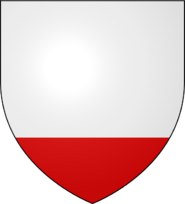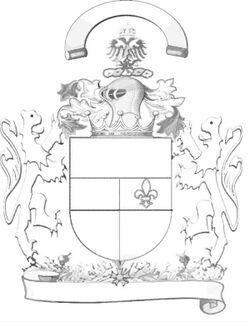Base (heraldry)
The base, more formally the terrace in base[1] or champagne,[2] is a heraldic charge that occupies the lower third of the field. It is in that sense the inverse correlate of the chief. In French heraldry, the champagne is considered an ‘honourable ordinary’ (‘pièce honorable’),[3] but in English heraldry it is frequently omitted from lists of the ‘honourable ordinaries’, and grouped, if at all, with the subordinaries.[4] The diminutive of the base, occupying one half the height of the ordinary, is termed ‘plaine’ in French heraldry.[5] Another, now less common, English language term for the base is the ‘Foot’,[6] a usage the recalls the Germanic Schildfuß, Danish skjoldfod, or Dutch schildvoet.
In English heraldry, the terms base, terrace in base, and champagne are synonyms that include both charges with a straight-line upper edge running parallel to the chief and those with an upper edge curved or otherwise varied. Standard variations are the mount and trimount.[7] In French heraldry in contrast, the terms champagne and its diminutive plaine are reserved for those with straight upper edges and the term terrasse (terrace in base) for those with curved or otherwise varied upper edges.[8] Champagnes that take a step-wise lines of division or variation are blasoned in French as "champagne pignonnée".[9] The latter (‘terrasse’) are furthermore classed as mobile charges rather than ‘honourable ordinaries’.
Gallery
Coat of arms
Méounes-lès-Montrieux (terrasse isolée[10])
Mount
Champagne pignonée
Plaine
On flags
See also
Chief (heraldry)
Side (heraldry)
Gallery of flags by design
References
- ↑ Brault, Gerard J. (1972). Early Blazon. Oxford: Oxford University Press. p. 138. https://archive.org/details/earlyblazon0000gera/page/138/mode/2up?q=%22terrace+in+base%22.
- ↑ Rothery, Guy Cadogan (1915). A. B. C. of Heraldry. London: Stanley Paul and Co.. p. 327. https://www.google.com/books/edition/A_B_C_of_Heraldry/ry_QAAAAMAAJ?hl=en&gbpv=1&bsq=champagne.
- ↑ Woodward, John; Burnett, George (1892). A treatise on heraldry British and foreign : with English and French glossaries. Edinburgh: W. & A.K. Johnston. p. 311. https://archive.org/details/treatiseonherald00wooduoft/page/310/mode/2up?q=champagne.
- ↑ Woodward, John (1896). A Treatise on Heraldry, British and Foreign With English and French Glossaries · Volume 1. Edinburgh and London: W. & A.K. Johnston. p. 126. https://www.google.com/books/edition/A_Treatise_on_Heraldry_British_and_Forei/QwMNAAAAYAAJ?hl=en&gbpv=1&bsq=champagne.
- ↑ de Mailhol, Dayre (1895). Dictionnaire historique et héraldique de la noblesse française. Paris: Direction & Redaction [Impr. Ch. Lépice]. pp. 61–62. https://www.google.com/books/edition/Dictionnaire_historique_et_h%C3%A9raldique_d/06SWZuK_A0IC?hl=en&gbpv=1&bsq=champagne.
- ↑ Barron, Oswald (1911). "Heraldry". Encyclopædia Britannica. 13 (11th ed.). pp. 311-330.
- ↑ Elvin, Charles Norton (1889). A dictionary of heraldry : with upwards of two thousand five hundred illustrations. London: Kent and Co.. p. 91. https://archive.org/details/dictionaryofhera00elvi/page/90/mode/2up?q=mount.
- ↑ de Mailhol, Dayre (1895). Dictionnaire historique et héraldique de la noblesse française. Paris: Direction & Redaction [Impr. Ch. Lépice]. pp. 61–62. https://www.google.com/books/edition/Dictionnaire_historique_et_h%C3%A9raldique_d/06SWZuK_A0IC?hl=en&gbpv=1&bsq=champagne.
- ↑ Gheusi, Pierre-Barthélemy (1892). Le blason héraldique: Manuel nouveau de l'art héraldique de la science du blason et de la polychromie féodale d'après les règles du moyen age avec 1300 gravures et un armorial. Paris: Librairie de Firmin Didot et c.. pp. 64, fig. 99. https://books.google.com/books?id=tbUTAAAAYAAJ&q=base#v=onepage&q=pignonn%C3%A9e&f=false.
- ↑ de Mailhol, Dayre (1895). Dictionnaire historique et héraldique de la noblesse française. Paris: Direction & Redaction [Impr. Ch. Lépice]. p. 186. https://www.google.com/books/edition/Dictionnaire_historique_et_h%C3%A9raldique_d/06SWZuK_A0IC?hl=en&gbpv=1&bsq=terrasse.
 |


























